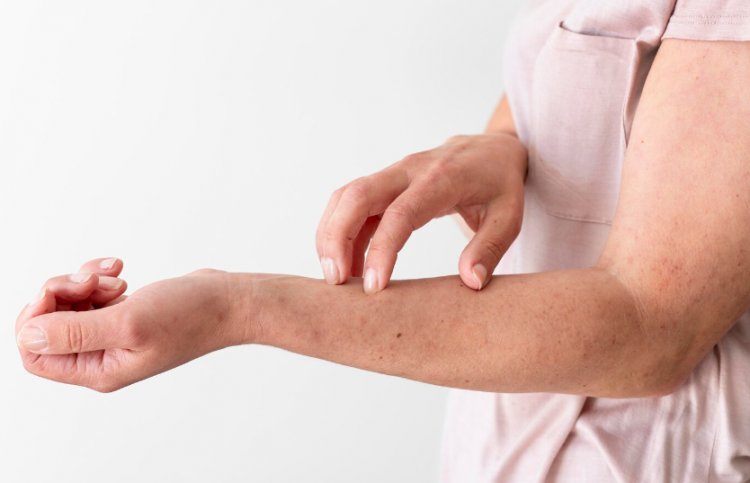Contact Dermatitis: Causes, Symptoms, Diagnosis, and Treatment
Contact dermatitis is a prevalent skin condition characterized by inflammation of the skin due to exposure to certain substances. It can cause discomfort and distress, affecting individuals' quality of life. Understanding the intricacies of contact dermatitis, including its causes, symptoms, diagnosis, and treatment, is crucial for effective management and prevention.

Causes
Contact dermatitis can be triggered by various substances, classified into two main categories: allergens and irritants.
Allergens: These are substances that induce an allergic reaction in susceptible individuals. Common allergens include metals like nickel, fragrances found in cosmetics and personal care products, preservatives like parabens, and plants such as poison ivy and poison oak.
Irritants: Unlike allergens, irritants directly damage the skin upon contact, leading to inflammation. Examples of irritants include harsh chemicals found in cleaning products, soaps, detergents, acids, and alkalis.
Occupational Exposures: Certain professions entail regular exposure to potential irritants or allergens, increasing the risk of developing contact dermatitis. Healthcare workers, hairdressers, and mechanics are among those at higher risk due to their occupational exposures.
Medications: Some topical medications, including corticosteroids and antibiotics, may cause contact dermatitis as a side effect in susceptible individuals.
Symptoms
The symptoms of contact dermatitis can vary in severity and presentation, but common signs include:
- Redness (Erythema): Affected skin areas often appear red or inflamed due to increased blood flow to the site of irritation.
- Itching (Pruritus): Itching is a hallmark symptom of contact dermatitis and can range from mild to severe, significantly impacting the individual's comfort.
- Swelling (Edema): Inflammation may lead to localized swelling, causing the skin to feel puffy or raised.
- Blisters (Vesicles): In more severe cases, contact dermatitis can result in the formation of blisters filled with clear fluid. These blisters may rupture, leading to oozing and crusting of the affected area.
- Dryness and Scaling: The skin may become dry, rough, or scaly, especially in chronic cases or with repeated exposure to irritants.
Diagnosis
Diagnosing contact dermatitis involves a thorough medical history, physical examination, and sometimes additional tests:
- Patient History: The healthcare provider will inquire about the patient's symptoms, including when they started, any recent exposures to potential irritants or allergens, and any previous history of skin conditions or allergies.
- Physical Examination: The affected skin area will be examined for characteristic signs of contact dermatitis, such as redness, swelling, blistering, and scaling.
- Patch Testing: In cases where the cause of contact dermatitis is unclear or suspected to be due to an allergen, patch testing may be performed. Patch testing involves applying small amounts of potential allergens to the skin under adhesive patches to identify specific triggers.
Treatment
Treatment for contact dermatitis aims to relieve symptoms, reduce inflammation, and prevent future flare-ups. Common treatment options include:
- Avoidance: The primary strategy is to identify and avoid the trigger substance whenever possible. This may involve lifestyle modifications, changes in occupation, or switching to alternative products.
- Topical Corticosteroids: These anti-inflammatory medications are commonly used to reduce redness, itching, and swelling associated with contact dermatitis. They are available in various strengths and formulations, with stronger corticosteroids prescribed for more severe cases.
- Topical Calcineurin Inhibitors: For individuals who cannot tolerate or do not respond to corticosteroids, topical calcineurin inhibitors such as tacrolimus or pimecrolimus may be prescribed to reduce inflammation and itching.
- Emollients and Moisturizers: Keeping the skin well-hydrated with emollient creams or ointments helps restore the skin barrier function and alleviate dryness and scaling.
- Oral Antihistamines: Antihistamines may be recommended to help relieve itching, particularly if it is disrupting sleep or daily activities. Non-drowsy formulations are often preferred for daytime use.
- Oral Corticosteroids: In severe cases of contact dermatitis, oral corticosteroids may be prescribed for short-term use to rapidly reduce inflammation and symptoms. However, long-term use of oral corticosteroids is generally avoided due to the risk of systemic side effects.
- Wet Dressings: Applying cool, wet compresses or dressings to the affected area can help soothe itching and inflammation, especially for acute flare-ups.
Prevention
Preventing contact dermatitis involves identifying potential triggers and taking proactive measures to minimize exposure:
- Avoid Known Allergens and Irritants: Individuals prone to contact dermatitis should familiarize themselves with common triggers and avoid products containing these substances.
- Protective Measures: When working with irritants or allergens, wearing protective clothing, gloves, and goggles can help minimize skin exposure and reduce the risk of contact dermatitis.
- Barrier Creams: Applying protective barrier creams or ointments before exposure to potential irritants can create a physical barrier between the skin and the offending substance, reducing the risk of irritation.
- Regular Skin Care: Maintaining good skincare practices, such as gentle cleansing and moisturizing, can help keep the skin healthy and resilient, reducing the likelihood of developing contact dermatitis.
- Patch Testing: Individuals with a history of contact dermatitis or suspected allergies may benefit from patch testing to identify specific triggers and inform avoidance strategies.
Conclusion
Contact dermatitis is a common skin condition that can significantly impact an individual's quality of life. By understanding the causes, symptoms, diagnosis, treatment, and prevention strategies associated with contact dermatitis, healthcare providers and patients alike can work together to effectively manage this condition and minimize its impact on daily life. Early recognition and intervention are key to successful management, allowing individuals to lead healthier, more comfortable lives free from the burden of contact dermatitis.
Centers or Clinics in the UK
- The Harley Street Dermatology Clinic (London)
- The London Dermatology Centre (London)
- The Dermatology Clinic London (London)
- Manchester Dermatology Centre (Manchester)
- The Birmingham Dermatology Clinic (Birmingham)
Centers or Clinics in Turkey
- İstanbul Dermatoloji Enstitüsü (İstanbul)
- Ankara Cilt ve Zührevi Hastalıklar Kliniği (Ankara)
- Dokuz Eylül Dermatoloji Merkezi (İzmir)
- Adana Cilt Hastalıkları Merkezi (Adana)
- Bursa Cilt ve Zührevi Hastalıklar Merkezi (Bursa)
Discover Coupoly's exclusive Medical Concierge Service, connecting you with renowned doctors and clinics, alongside our complimentary Travel Concierge Service, linking you with top UK travel agencies.
Contact us now to learn more.
Get in Touch
What's Your Reaction?





















